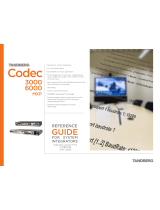
D15363.02 Cisco TelePresence DX70 and DX80 API Reference Guide CE8.2, SEPTEMBER 2016. Copyright © 2016 Cisco Systems, Inc. All rights reserved. 5
Cisco TelePresence DX70 and DX80 API Reference Guide
New features and improvements
LDAP user management
In CE8.2, you can register users with ADMIN role from an
external LDAP service to grant them access to the video
system’s web interface and API. This allows for central-
ized management of ADMIN users. The LDAP server can
be configured from the web interface. Authenticating users
with the USER role using LDAP is not supported.
LDAP configuration can be set from CUCM. If the video
system requires a certificate for login from LDAP, it must
be uploaded to the codec manually as CUCM is unable to
provision certificates.
Administrator credentials not needed for remote pairing to
a Touch 10
You no longer need to enter administrator credentials
when you remote pair a Touch 10 controller to a video
system. All user credentials can be used for this purpose.
The administrator doesn’t have to visit the site or provide
administrator credentials in order to pair or re-pair a touch
controller to a video system.
Un-pairing the Touch 10 controller and changing advanced
settings still require admin credentials.
Additional entry points for in-room controls
In-room controls now have an option for multiple panels
that are available depending on the context. This provides
more flexibility to add multiple panels for various tasks
instead of putting all actions into one panel.
There are now three entry points available for in-room
controls: Global (introduced in CE8.1), Homescreen and
In-Call. The Homescreen entry point is located on the
home screen icon tray, next to the Dial, Contacts, and
Share buttons. The In-Call entry point is located in the icon
tray, and is accessible when the video system is in a call.
New panel icons have been added.
Cisco Spark support
CE8.2 introduces support for Cisco Spark activation for
SX10 (CTS-SX10-K9), SX20, SX80, MX200 G2, MX300 G2,
MX700, MX800, MX800D, DX70 and DX80. A video system
registered to the Cisco Spark service can be used together
with Cisco Spark mobile and desktop applications.
To register to Cisco Spark:
• Touch 10 must be directly paired (Touch 10 is not
supported for Spark registered SX10N, SX10, SX20,
DX70 and DX80)
• Encryption Option key must be installed (Does not
apply to DX70 and DX80)
When the video system is activated on Cisco Spark, it
downloads the newest version of Cisco Spark Room OS.
Cisco Spark Room OS does not have the same manage-
ment capabilities as Collaboration Endpoint Software as its
web and command line interfaces are locked. The Room
System is managed by Cisco and if there are any issues,
contact Cisco Technical Assistance center through the
Cisco Spark mobile application or from the management
portal.
For more information on the Cisco Spark Room OS and its
features see: https://help.webex.com/
Cisco Proximity updates
The application name has changed from Proximity to Cisco
Proximity.
The latest release includes the following improvements:
• First time use tutorial for desktop application
• Updated look for the user interface
• Improved pairing experience
• Increased visibility on the user’s desktop
• Better information and handling of failure scenarios
• Link to support forums on the client
The Cisco Proximity clients for smartphones and tablets
(Android and iOS), and laptops (Windows and OS X) can be
What’s new in CE8.2
This section provides an overview of the new and
changed system settings, and the new features and
improvements in the Cisco Collaboration Endpoint
software version 8.2 (CE8.2) compared to CE8.0.
The list of new commands includes all changes from
CE8.0 to CE8.2.
As CE software is based on TC7, the structure and main
functionality remains the same as in TC software.
For more details, we recommend reading the Software
release notes:
http://www.cisco.com/c/en/us/support/
collaboration-endpoints/desktop-collaboration-experi-
ence-dx600-series/products-release-notes-list.html
It is important to consider the upgrade
requirements of CE8 before upgrading; other-
wise upgrading to CE8 can leave you with a
non-functioning deployment that requires you to
downgrade.
























